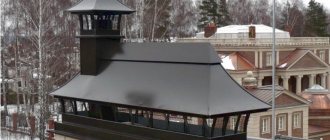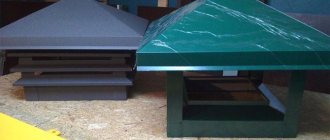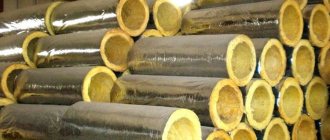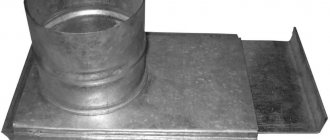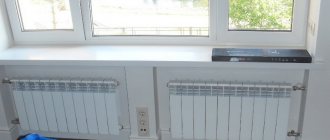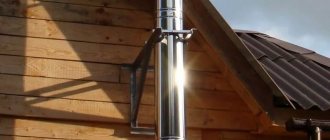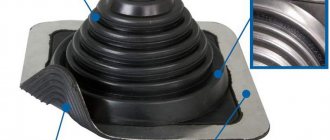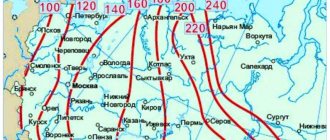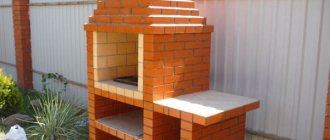Good afternoon, dear reader! To vent the mixture of gas and fuel combustion products outside, stoves, fireplaces and boilers must be equipped with smoke exhaust ducts. Their head is covered with a special visor or umbrella. At first glance, these products seem to be only decorative elements. But in fact, the cap on the chimney pipe performs a very important function in the chimney system. It can significantly increase the energy efficiency of the heating system as a whole, and also eliminate any risk of smoke in the home.
Making your own deflector
The cost of this device starts from 1000 rubles, the upper mark is noticeably higher.
The feasibility of self-manufacturing and installation is not worth explaining. A convector chimney is a good alternative to radiator heating devices. It has many advantages and has a simple design. It's not difficult to do it yourself.
It is preferable to assemble a do-it-yourself chimney deflector from galvanized steel. But recently, a replacement has been found in the form of metal, which is coated with a protective polymer layer or simple enamel. In cases where the chimney does not come into contact with hot streams of combustion products, it can be made of plastic ( Read the article about in addition to this material
).
Video: instructions for creating a chimney deflector with your own hands
Before you start creating a deflector, you need to make a drawing on which all the dimensions of the future product will be plotted. When choosing a size, you should start from the diameter of the chimney pipe. This value will determine the height of the chimney itself and the width of the diffuser. There is a table with standard ratios of chimney and deflector sizes:
To make a chimney deflector with your own hands, it is better to make the drawings in full size. Confusion with scales can significantly delay the manufacturing process.
Necessary tools that will be required for work:
- Drawing set. Measuring tape, marker, ruler.
- Metal scissors, wooden hammer, rivet tool.
- Drill and drill bits of various diameters.
Stages of work
First you need to choose the type of metal to make the deflector. After which, having completed the calculations and made sure that they are correct, you can begin to cut out the parts of the chimney from metal. The development of the diffuser body must be rolled into the shape of a plate, then, through the drilled holes, the ends must be fastened with rivets.
The upper and lower cones are riveted together, after which fasteners are installed on the lower cone to connect the device to the chimney pipe. We advise you to study in more detail on our website.
To install the chimney on the flue duct, it is better to remove its upper module. Using a workbench, the structure is assembled and then installed in place.
Material for making fungus for ventilation pipe
To make the fixture more attractive, it can be painted to match the color of the roof covering. Since products made of black steel look unattractive, they are usually decorated with forged elements. Unfortunately, steel models have a significant drawback - their heavy weight, so this option is not suitable for all roofs.
On sale you can find mushrooms made of copper and alloy steel, which are durable, but at the same time have a high cost. Therefore, the choice of material from which this product is made largely depends on the financial capabilities of the home owner. You can purchase a ready-made device for a pipe on the market or make it yourself, which is quite within the capabilities of home craftsmen.
How to make a fungus on a pipe with your own hands
Making a chimney cap yourself is not an easy task. If you do not have much experience in this area, you can first transfer the drawing to a sheet of cardboard, cut it out and think about ways of connecting and fastening. After the picture becomes more or less clear, you can cut out the metal parts and start assembling
It is very important to measure the chimney accurately and strictly adhere to the measured values during manufacture
Here is one of the drawings of a chimney in the form of a small pitched roof. The angle is determined by the formula indicated on the first sheet.
Drawing of a chimney cap
Drawing of a chimney cap
The procedure is as follows:
- Place the metal blank on the table face up, in the place indicated in the drawing, drill a hole with a diameter of 3.5 mm.
- Bend the part along all the dotted lines by 90 degrees. For this it is better to use a sheet bending machine. Then the lines will be clear, without dents. If there is no such device, you will have to use improvised means: fix a piece of corner on a workbench with the shelf up. To be able to bend the entire (or almost the entire) line at once, you can use a block.
- Bend the part along the lines “d”. The angle is determined experimentally: a solid cap should be obtained. The structure should be level, without distortions (put it on the table to check). If everything “comes together”, mark a point on the lower stiffening rib with a marker through the drilled hole, mark the future hole, then drill.
- Connect the cap and secure with a 3.2mm rivet.
- Fold everything along lines “a” and “b” so that the legs can be installed.
- Along the outer perimeter of the pipe, make the base of the cap from the corners. Place the corners so that one edge rests against the masonry, and the other is on the side. Prepare the “legs” for the cap. Everything is connected by welding.
- The finished base must be cleaned, coated with an anti-corrosion compound, then painted in several layers with paint for exterior use.
- Connect the cap to the base.
If making a square chimney seems difficult to you, maybe this option will be easier. Its implementation will be quite simple if you have a piece of curved sheet metal of the appropriate size. If you have a regular sheet, you can bend it using a special device (usually available from tinsmiths).
Do-it-yourself smoker
The procedure is as follows: prepare the base of the cap from the corner according to the measurements of your chimney. Place the corner so that the structure holds well: one edge rests on the edge of the chimney, the other covers it from the outside. Make legs that will support the cap and connect it to the base. Make them strong enough to withstand wind loads and withstand snow loads. Treat all parts with an anti-corrosion compound and paint. Assemble the structure into a single whole. The collection method depends on the material.
Here is an example of how to make a deflector for a metal pipe. The author of this video has it installed on a basement ventilation pipe, although a similar design can be used on a metal pipe from a solid fuel boiler.
This video shows how to make a regular umbrella for a pipe.
You're always welcome)) How to attach the cap depends on the pipe material. Judging by the fact that the development is only square or rectangular, you have a brick pipe. If so, you can attach the weather vane to dowels, and more often. And not into the seam, but only into the brick. If the winds are strong, you can make the lower part, which will be put on the pipe, wide and beat the fasteners not in one row, but in a checkerboard pattern: from top to bottom. If you didn’t get the material right, please unsubscribe.
Planning passages for ventilation
Diagram of air circulation and ventilation output to the roof
You should begin to properly equip your ventilation system by thinking through and drawing up a schematic diagram of the ventilation of your entire home.
Let's look at this situation as an example: according to the renovation plan for a residential building, the roof needs to be replaced. Through the new roof you need to remove hoods from the rooms, from the bathroom, a ventilation duct from the basement and a kitchen hood. The question arises, what will happen if you do not make four passes, but bring all the channels together and place only one ventilation pipe on the roof?
Knowledgeable people say that nothing good will come of such savings. It is still desirable to have its own separate ventilation passage through the roof for each of the air ducts. Otherwise, if they are all combined, an unpleasant odor may spread throughout the house when weather conditions provoke backdraft.
Types of chimney caps
The shape of the chimney must correspond to the cross-section of the pipe.
Thus, chimney caps can be:
- round;
- square;
- rectangular.
Main design options for chimneys:
- cap-house with a hipped roof;
- house with gable roof;
- chimney with a semicircular roof;
- cap with a cone-shaped umbrella;
- with a flat umbrella.
Smokers can be equipped with additional elements:
- spark arrester;
- forged ornament;
- weather vane and so on.
If the spark arrester is a purely functional element, then openwork forging is necessary to give the cap an original and attractive look. It also serves as protection from debris and birds, but a regular grill will cope with these tasks. The weather vane not only shows the direction of the wind and acts as a decoration - thanks to its presence, the draft in the pipe increases.
Manufacturing materials
For the manufacture of chimney caps the following are used:
- galvanized sheet steel;
- stainless steel;
- copper.
Galvanized steel pipe heads withstand aggressive environmental influences well, they are practical and do not lose their color for a long time under sunlight. They can be additionally coated with colored polymer material (polyester).
You can find such caps on sale in any color, this allows you to choose a shade that will harmoniously match the color of the pipe and roof. Stainless steel is a higher-class material; products made from it will be more durable.
Copper is the most durable material for a chimney cap. If installed correctly, such a chimney will last more than a hundred years. Copper caps go well with gutters and other elements made of this metal, as well as with roofing made of natural tiles.
Over time, a head made of this metal will not only not lose its appearance - on the contrary, it will become covered with a noble patina.
What to consider when installing ventilation outlets
There are a number of factors to consider when installing. The shape of the roof matters, which can be pitched or flat.
In the first case, engineers recommend installing the ventilation outlet as close to the ridge as possible. This will ensure uniform heating of the inside of the ventilation pipe, and the outside will be more resistant to wind and snow pressure in winter.
For a flat roof, the geometry of the ventilation outlet riser comes to the fore: it should be located directly under the exhaust pipe on the roof so that the air can flow out unhindered.
The height of the ventilation shaft above the roof is also important: if the pipe is not high enough, the draft force will be very small and the ventilation will not work effectively. A pipe that is too high also reduces draft, because the structure may be damaged by strong gusts of wind, so additional fastening will be required.
Making your own fungus for a pipe
First of all, you should prepare supplies and tools, including:
- wooden or rubber mallet;
- metal sheet 10 millimeters thick;
- marker;
- scissors for metal work;
- ruler;
- metal corner 50 millimeters wide and 1 meter long;
- a pair of gloves.
Before starting work, you need to make a drawing on a sheet of cardboard and try on the workpiece.
The sequence of actions when making a fungus on a ventilation pipe will be as follows:
- A rectangle of a certain size is measured on a metal sheet and cut off.
- To make a blank for a round lid with a cut edge, you need to cut a circle from a rectangle and cut a 45-degree corner to the center.
- The edges of the plate are bent using a mallet.
- The workpiece is given a sloping bend. To do this, you can use the corner of a desktop or the surface of an iron corner.
- The workpiece is connected along the fold lines and processed with a mallet.
- To eliminate shape errors, it is necessary to walk the workpiece along a flat surface. Now the hat is ready.
- For the base you also need to cut out a rectangle. To know its length, take measurements from the pipe and add a few extra centimeters. The ends of the workpiece are processed with a mallet. Give the plate a cylindrical shape and connect the ends.
- 3-4 legs are made from the remains of the metal sheet, folding the pieces in half. Holes are drilled at their ends, then the legs are bent from below.
- Holes are drilled in the cap at regular intervals and the legs are attached with rivets.
- Try the cap on the base and use a marker to mark the places for the rivets. Having drilled holes, fasten the fungus structure with rivets.
Before proceeding with final assembly, you need to make sure that the cap is even by placing the cone on the most flat surface possible. Before painting the product, before connecting the elements, the workpiece is cleaned, primed, and coated with an anti-corrosion agent. The paint composition for exterior work is applied in 2 – 3 layers.
DIY making
Before you make a fungus on a pipe with your own hands, you need to choose a model. Standard cap designs are recommended for beginning craftsmen.
The work will require:
- steel sheets;
- scissors for working with metal raw materials;
- ruler or measuring tape;
- sheet benders;
- markers;
- sheets of cardboard;
- welding device, etc.
The protective fungus is installed in several stages:
- measurements;
- drawing up a product drawing;
- transferring data to a metal sheet;
- creation of blanks;
- assembly.
Work begins with measuring the dimensions of the chimney pipe and developing drawings of structural elements on a sheet of cardboard or thick paper. It is necessary to add up to 5 mm to the standard dimensions for comfortable placement of the product on the pipe.
After checking the accuracy of the measurements, the data is transferred to the material, the lines are marked with a marker. Metal scissors are used to cut out blanks for the product.
The elements are placed on a flat surface. Using a sheet bender, the lines marked on the canvas are sequentially formed to the angle required by the design (average 90°). In places for connection, 3 openings are made at a distance of about 15 cm. The elements are fixed with rivets.
Brackets are made from metal sheets. The elements are welded to the umbrella and apron. The joints are treated with a metal primer.
Finally, the cap is coated with an anti-corrosion compound and paint in 1-2 layers. The structure dries for 1.5-2 hours and is attached to the base of the pipe.
Master class from the Country Master on how to make a cap for a chimney pipe
Watch this video on YouTube
The principle of operation of the cap on the chimney pipe
- The air flow, hitting the walls of the upper cylinder, bends around it from all sides.
- The air stream, sliding along the surface of the cylinder, turns upward, thereby sucking in the smoke coming out of the pipe.
- The movement of air inside the pipe becomes more intense, therefore, the draft increases.
- When wind flows are not horizontal, but vertical or at an angle, the wind vane also helps to increase traction. Wind currents penetrate the upper cylinder through the gap and suck smoke into the chimney.
- When there is a low wind, vortices are formed under the weather vane hood, which slow down the release of smoke.
High-quality and competent organization of draft in the chimney system is, first of all, not only the safety of the people living in the house, but also a prerequisite for the proper operation of the heating system. Therefore, it is worth taking the time to make and install a chimney umbrella yourself. This simple device will help not only to organize the correct operation of the heating system, but also to eliminate weak draft in the pipe.
Possible mistakes
There are a number of errors that prevent you from doing the job correctly and efficiently. Most often people forget about sealants. Without it, it is not possible to create a sealed structure, as a result of which moisture and debris enter the house through the ventilation system.
Another common mistake is using materials that cannot resist moisture. As a result, the entire structure wears out very quickly and has to be replaced after 1-2 years of operation.
Another common mistake is drawing up the wrong project. For example, if pipes from several rooms located at different levels are connected to one channel, then the efficiency of removing polluted air will suffer greatly.
How to choose
When choosing a hood, you need to base it on the functions for which it will be intended.
When choosing a ventilation hood, you should pay attention to the following characteristics:
- Dimensions. To select the size, assume that the width is 10 centimeters larger than the surface for which it will be installed.
- Room temperature. When choosing, you should take into account the temperature of the vapors and gases entering the chimney. On this point, it is better to consult a specialist.
- Air flow. This indicator is calculated from the volume of the room, power and number of installed plates. Prepare this information before purchasing and present it to a specialist.
- Air speed and resistance. The air exchange of the umbrella should be from 0.8 to 1.5 meters per second. If the speed indicator is lower, this will significantly reduce the quality of work.
When choosing, pay attention first of all to the type of umbrella you need (see above), and when purchasing and manufacturing, proceed from this parameter
Building regulations
The rules for arranging ventilation systems are set out in SNiP 2.04.05-91.
The basic requirements for installing fungi are as follows:
- mandatory air conditioning in bathrooms, living rooms, food preparation areas, and vegetable stores;
- presence of fresh air supply;
- the location of the fungus above the roof ridge;
- installing an exhaust fan in a long duct;
- installation of a separate flue for heating boilers;
- if the hood is vented into the attic, it must be ventilated;
- the ability to output individual channels to a common one, provided that the difference in their height is no more than 2 meters.
In areas with cold climates, not only insulation of the channels is provided, but also their heating.
Form and function
The main tasks of the chimney cap:
- Increased air draft;
- Protection against birds accidentally flying into the pipe;
- Preservation of the chimney masonry;
- Protection from snow and rain.
Please note: the use of a hood increases the efficiency of the chimney by almost 20 percent.
The pommels differ in geometry, shapes and sizes. Their varieties are determined by the style of the facade of the house and the peculiarities of the weather vagaries of the area.
- Umbrella (cover) – protects the pipe from rain and snow. Can be made in the form of a weather vane, flat cover or gable cover.
- Drip cap - removes moisture from the pipe walls and stops the formation of ice.
Caps are made from materials that are resistant to the destructive effects of weather conditions. This product is fixed in a very hard-to-reach place, so it is better not to save money and purchase stainless steel or sheet copper.
Some features of the use of caps:
- The semi-circle shaped deflector is more suitable for European design;
- An umbrella with a flat top will look natural on a cottage in the Art Nouveau style;
- A wind vane with a weather vane installed can be equipped with a damper, which will make the pipe work effectively even in the absence of wind;
- A weather vane with a gabled top promotes intensive ventilation;
- Hoods with a movable roof make it easy to clean the chimney.
Design
A chimney cap is a device that resembles an umbrella or canopy in appearance and is installed on the head of the chimney to protect against moisture. There are a huge number of variations in the appearance of weather vanes, depending on the shape and size of the smoke exhaust duct. The design of all types of hoods consists of the following elements:
- Protective umbrella. The top of the cap is in the form of a cone, pyramid, semicircle or other more complex shapes. The umbrella protects the chimney from precipitation, debris, and birds from entering the chimney.
- Drip apron. This element of the cap protects the pipe head from drops bouncing off the umbrella. It helps to increase the service life of the chimney, prevents corrosion and fungus. The apron is used when a cap is installed on a rectangular or square pipe.
Important! For a chimney, you can make a cap with your own hands from sheet metal, however, more complex models are easier to buy or order. The most convenient type to maintain and operate is a protective umbrella with an opening lid. Due to the mobility of this element, the protective visor is not removed during cleaning or inspection of the chimney.
To make a durable cap for the chimney pipe, sheet metal that is not subject to corrosion is used. DIY production from galvanized steel, copper or aluminum is common. An umbrella with a copper head has a noble shade, it looks respectable, but often becomes a “victim” of non-ferrous metal collectors.
Installing a protective apron around the pipe
To ensure that the connection of the roof deck to the chimney system is airtight, an apron is installed on the roof slope.
Or rather, two are installed: internal and external. The inner one is under the finishing roof deck, and the outer one is above it. A waterproofing flashing is necessary to prevent melt water from getting into the attic and into the house. You need rolled metal sheets with a height of 40-45 cm. A flexible lead or aluminum tape, which can be easily cut with metal scissors, is suitable. On the pipe at a height of 20 - 25 cm from the rafters, a line is marked on all four sides, which will be parallel to the rafter flooring. A 1.5 cm deep groove is laid along this line along the entire perimeter. You can cut it with a grinder, then wash the cut or blow off the sawdust.
The installation of a metal apron begins with the bottom wall of the pipe. Take a piece of sheet 15 cm longer than the width of the pipe wall. To enter the groove, bend the tin along the edge by 1 cm at an angle of 90º in one direction and after 20 - 25 cm bend the remaining part at an angle of 90º in the other direction, use the remaining 20 cm to overlap under the roof covering. This will prevent leakage. Do this on all four sides. Fill the edges of the additional elements inserted into the groove with heat-resistant sealant.
After the finishing roof covering has been installed, you can install an external apron. It is more necessary as an aesthetic element. Therefore, a material is selected for it that will be harmonious with the roof. It is easy to select rolled products with a polymer coating both in color and quality. An apron for a round chimney can be purchased in a store; it comes in metal with adjustable sizes and silicone (rubber), which is easily adjusted due to the elasticity of the material. Making a roof passage by hand is even easier than making a chimney cap.
Such a structure can only be attached to the roof system. since shrinkage of the house can play a cruel joke and prematurely damage either the pipe or the apron. A clamp with an elastic heat-resistant gasket must be put on the pipe.
Wind vanes on the chimney pipe
How and from what to make umbrellas for chimney pipes. Headband for a chimney pipe. Installation of a chimney on the roof.
Installation of MP MAXI output on metal tiles
MP MAXI 110-125 is installed on metal tiles when installing under-roof ventilation or exhaust hood. The total height of the element is 77 cm, the height above the roof surface is 50 cm. The material of manufacture is impact-resistant polystyrene.
Peculiarities:
One-piece design, the cap is already assembled and installed, the shape of the flange corresponds to the geometry of the metal tile profile, which simplifies and speeds up installation.
On the base there is a high-quality seal to reliably protect the joint with the roofing material.
The external size is increased, which further increases the strength of the element and protects it from damage when ice and snow melt in large quantities.
Installation procedure:
- the exit is placed at the level of the air duct, the contour of its base is outlined and a hole is made in the roofing material;
- The element is fastened using self-tapping screws. If there is no seal on the base, additional sealant is applied to the joint;
- the pipe is leveled and installed vertically by scrolling the lower part along its axis. Can be installed on slopes with an inclination angle of 30-60°;
- the insulated pipe is connected to the air duct without a transition element. If necessary, use a corrugated pipe;
- areas where the air duct passes through layers of vapor and waterproofing are sealed with self-adhesive tapes.
On roofs covered with MP-20, S-21, NS-35 corrugated sheets, MP MAXI is installed in the same way.
Equipment:
- pipe;
- passage element with mounted cap;
- adapter diameter 125-110.
Insulated pipe
Used when connecting to air ducts:
- insulated along the entire length;
- complete with adapter 125-110 mm, allows the use of pipes and air ducts of different diameters;
- is easy to install;
- designed for use in difficult climatic conditions.
How to choose a cap
Most often, heads with a hipped roof are used for brick pipes, and chimneys with cone-shaped umbrellas are used for round pipes.
However, it is worth paying attention to other options. For example, a cap with a gable top provides better protection from snow
IMPORTANT!
The shape of the chimney cap is not so important. In order for it to fully perform its functions, the main thing is to choose the right size. The overhangs of the umbrella should protrude several centimeters beyond the outer perimeter of the pipe on all sides.
If you want to ensure that leaves and other debris, as well as birds, do not get into the pipe, you need to opt for a cap with a mesh located under the umbrella. The role of the mesh can be played by artistic openwork forging; such heads not only cope with the tasks assigned to them, but also have an excellent appearance.
- Painted chimneys are not suitable for wood stove pipes, as the paint fades quickly.
- Heads with a sealed double lid better withstand exposure to hot air, and two-story models allow for better ventilation.
- A cap with a deflector will provide the best possible draft and thus increase heating efficiency.
- If you install a cap with a hinged lid on the pipe, it will be easy to clean.
When choosing a cap, you need to find a model that not only looks good, but also harmoniously combines with the rest of the elements of the roof and the house in general and will fit well into the exterior of the building.
Types of different caps
For buildings that have a distinctly modern look, caps with a flat roof are suitable, and for most standard “classic” brick houses, the best choice would be a cap with a hipped, gabled or semicircular cap.
To correctly select the size of a cap umbrella for a brick pipe, you need to measure its length and width. If there is an extension at the top of the chimney, the umbrella must cover it too, which means that it is necessary to focus specifically on the dimensions of the outer perimeter of such an extension. The base of the cap should fit easily onto the chimney, but it should sit tightly; to find the required dimensions of its long and short sides, add 4-5 mm to the length and width of the pipe.
Varieties
The abundance of shapes and types of chimneys force manufacturers to produce caps of various shapes, styles, and sizes. In construction stores you can find the following types of products:
- Standard weather vane. Her umbrella is a pyramid made of sheet metal, attached to a drip apron using brackets.
- Four-slope weather vane. The top of such models resembles a hipped hip roof. As a rule, they are used for rectangular brick pipes.
- Wind vane with a semicircular umbrella. It is used for installation on the roofs of European-style houses. From the point of view of increasing traction, it has low efficiency, however, it looks beautiful on the slope.
- Flat weather vane. It is equipped with a flat rectangular umbrella and is used for buildings in the minimalist and modernist styles. The flat cover of the hood does not allow snow to roll off, which is why the brackets of such models experience increased load and sometimes become deformed.
- Round weather vane with a cone-shaped umbrella. They are used to protect round stainless steel pipes; such models are not equipped with a drip line.
Note! Wind vanes are equipped with additional functional elements: dampers, double roofs, folding doors. Don’t get carried away with elaborate details, because the main thing in choosing a deflector is durability and efficiency. An ill-conceived shape can cause noise or vibration in the pipe.
Installing the deflector
Its effectiveness has been proven by many owners of houses and cottages who have used this model.
Despite the fact that the price of such products can reach up to $140 for standard designs, the demand for them remains constant. In order not to overpay, you can make the described device yourself. The whole process will take no more than 3 hours. It all depends on the skills of the collector. At the first stage, a drawing is created, after which the blanks are made. Next comes the assembly of the device and its installation on the chimney, followed by fastening.
Before drawing drawings, you should calculate the diameter of the outlet pipe and the diameter of the cap
It is also important to measure the height of the deflector itself. To prevent mistakes at this point, special formulas will help:
- height=1.6−1.7 x diameter;
- diffuser width=1.2−1.3 x diameter;
- cap width=1.7−1.9 x diameter.
After drawing the outline of the blanks on paper, you can proceed to creating metal blanks.
It is better to take stainless or galvanized steel, the thickness of which varies from 0.5 to 1 mm. After preparing the metal pattern, you can begin the assembly stage of the product. This will require a drill, riveter or welding. If the latter option is preferred, maximum care must be taken so as not to burn through the deflector section.
The cap is secured to the base with legs, which are drawn in the same way on paper and then cut out from a sheet of stainless steel. When all these stages have been completed, only the most crucial moment remains - installation on the chimney.
Drill holes on the pipe to secure the deflector. Rivets are fixed. After this, you need to check whether the installed device has a slope in different directions. Installation of a clamp will be required if the deflector is loose. If the pipe is not made of brick, this option will come in handy. If we are talking about a ceramic pipe, then you will have to use special adapters.
European cap
This model is more designed to prevent the formation of condensation and has a rounded appearance. A chimney of this type can be made independently using a steel sheet and hand-made holders.
How to make a European cap:
Take a standard metal sheet and carefully bend it around the pipe, or directly along the contour of the chimney. They remake the spoons that will hold the cap directly on the pipe. It is best to do this with a special machine or ask a welder you know
You can also make transverse cuts that do not go all the way and carefully bend the strips using pliers. These cuts do not have to be transverse. It is permissible to use longitudinal strips if the piece of metal is quite long
A rectangle is cut out along the edges and the tails are left in the center. After this, roll the sheet in the shape of a semicircle and press the tails with a clamp. Gently bend the legs.
It is permissible to use a regular chimney pipe clamp to mount such a cap on the pipe.
To make a European cap, all you need is a piece of sheet metal and a grinder disc.
Ventilation of the under-roof space
Moisture is always absorbed in the under-roof layer. This happens due to:
- water condensation inside the living space,
- absorption of moisture on the inner surface of the metal roof,
- accumulation of moisture from the external environment.
The service life of the roofing substructure is reduced due to the negative influence of excess humidity, which causes the spread of mold and harmful fungi. Differentiation of pressure and air flow is the basis of ventilation. In this regard, it is recommended to create a sufficient supply of air from under the eaves and gable overhangs of the roof.
